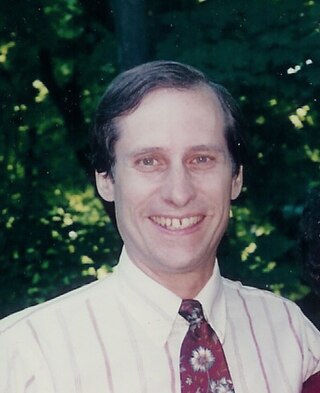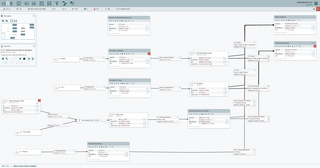Related Research Articles
HyperCard is a software application and development kit for Apple Macintosh and Apple IIGS computers. It is among the first successful hypermedia systems predating the World Wide Web.
In computer science, static program analysis is the analysis of computer programs performed without executing them, in contrast with dynamic program analysis, which is performed on programs during their execution.

Thomas Leo Clancy Jr. was an American novelist. He is best known for his technically detailed espionage and military-science storylines set during and after the Cold War. Seventeen of his novels have been bestsellers and more than 100 million copies of his books have been sold. His name was also used on screenplays written by ghostwriters, nonfiction books on military subjects occasionally with co-authors, and video games. He was a part-owner of his hometown Major League Baseball team, the Baltimore Orioles, and vice-chairman of their community activities and public affairs committees.

Design Patterns: Elements of Reusable Object-Oriented Software (1994) is a software engineering book describing software design patterns. The book was written by Erich Gamma, Richard Helm, Ralph Johnson, and John Vlissides, with a foreword by Grady Booch. The book is divided into two parts, with the first two chapters exploring the capabilities and pitfalls of object-oriented programming, and the remaining chapters describing 23 classic software design patterns. The book includes examples in C++ and Smalltalk.

Randal L. Schwartz, also known as merlyn, is an American author, system administrator and programming consultant. He has written several books on the Perl programming language, and plays a promotional role within the Perl community. He was a co-host of FLOSS Weekly.

Aldus Corporation was an American software company best known for its pioneering desktop publishing software. PageMaker, the company's most well-known product, ushered in the modern era of desktop computers such as the Macintosh seeing widespread use in the publishing industry. Paul Brainerd, the company's co-founder, coined the term desktop publishing to describe this paradigm. The company also originated the Tag Image File Format (TIFF) file format, widely used in the digital graphics profession.
Software development is the process used to conceive, specify, design, program, document, test, and bug fix in order to create and maintain applications, frameworks, or other software components. Software development involves writing and maintaining the source code, but in a broader sense, it includes all processes from the conception of the desired software through the final manifestation, typically in a planned and structured process often overlapping with software engineering. Software development also includes research, new development, prototyping, modification, reuse, re-engineering, maintenance, or any other activities that result in software products.

In computing, a visual programming language or block coding is a programming language that lets users create programs by manipulating program elements graphically rather than by specifying them textually. A VPL allows programming with visual expressions, spatial arrangements of text and graphic symbols, used either as elements of syntax or secondary notation. For example, many VPLs are based on the idea of "boxes and arrows", where boxes or other screen objects are treated as entities, connected by arrows, lines or arcs which represent relations.
Boost is a set of libraries for the C++ programming language that provides support for tasks and structures such as linear algebra, pseudorandom number generation, multithreading, image processing, regular expressions, and unit testing. It contains 164 individual libraries.

Avram Joel Spolsky is a software engineer and writer. He is the author of Joel on Software, a blog on software development, and the creator of the project management software Trello. He was a Program Manager on the Microsoft Excel team between 1991 and 1994. He later founded Fog Creek Software in 2000 and launched the Joel on Software blog. In 2008, he launched the Stack Overflow programmer Q&A site in collaboration with Jeff Atwood. Using the Stack Exchange software product which powers Stack Overflow, the Stack Exchange Network now hosts over 170 Q&A sites.

Mercurial is a distributed revision control tool for software developers. It is supported on Microsoft Windows, Linux, and other Unix-like systems, such as FreeBSD and macOS.
In computer programming, flow-based programming (FBP) is a programming paradigm that defines applications as networks of black box processes, which exchange data across predefined connections by message passing, where the connections are specified externally to the processes. These black box processes can be reconnected endlessly to form different applications without having to be changed internally. FBP is thus naturally component-oriented.

Wayne P. Stevens was an American software engineer, consultant, author, pioneer, and advocate of the practical application of software methods and tools.
Peter Mark Rinearson is an American journalist, author, entrepreneur and executive. He is a winner of the Pulitzer Prize and a former vice president of Microsoft. Much of his career has focused on enhancing tools for storytelling, from Microsoft Word to web publishing to social media.

Oscar Marius Nierstrasz is a professor at the Computer Science Institute (IAM) at the University of Berne, and a specialist in software engineering and programming languages. He is active in the field of programming languages and mechanisms to support the flexible composition of high-level, component-based abstractions, tools and environments to support the understanding, analysis and transformation of software systems to more flexible, component-based designs, secure software engineering, and requirement engineering to support stakeholders and developers to have moldable and clear requirements. He has led the Software Composition Group at the University of Berne since 1994 to date.

Mike Cohn is one of the contributors to the Scrum software development method. He is one of the founders of the Scrum Alliance.
Software-defined networking (SDN) technology is an approach to network management that enables dynamic, programmatically efficient network configuration to improve network performance and monitoring, in a manner more akin to cloud computing than to traditional network management. SDN is meant to address the static architecture of traditional networks and may be employed to centralize network intelligence in one network component by disassociating the forwarding process of network packets from the routing process. The control plane consists of one or more controllers, which are considered the brains of the SDN network, where the whole intelligence is incorporated. However, centralization has certain drawbacks related to security, scalability and elasticity.
Thomas W. Reps is an American computer scientist known for his contributions to automatic program analysis. Dr. Reps is Professor of Computer Science in the Computer Sciences Department of the University of Wisconsin–Madison, which he joined in 1985. Reps is the author or co-author of four books and more than one hundred seventy-five papers describing his research. His work has covered a wide variety of topics, including program slicing, data-flow analysis, pointer analysis, model checking, computer security, instrumentation, language-based program-development environments, the use of program profiling in software testing, software renovation, incremental algorithms, and attribute grammars.

Apache NiFi is a software project from the Apache Software Foundation designed to automate the flow of data between software systems. Leveraging the concept of extract, transform, load (ETL), it is based on the "NiagaraFiles" software previously developed by the US National Security Agency (NSA), which is also the source of a part of its present name – NiFi. It was open-sourced as a part of NSA's technology transfer program in 2014.
References
- ↑ "J. Paul Morrison obituary". legacy.com.
- ↑ "J Paul Morrison : Biography". jpaulm.github.io.
- ↑ Gabe Stein (August 2013). "How an Arcane Coding Method From 1970s Banking Software Could Save the Sanity of Web Developers Everywhere". Fast Company. Retrieved 9 August 2023.
- ↑ https://books.google.nl/books/about/Flow_based_Programming.html?id=R06TSQAACAAJ&source=kp_author_description&redir_esc=y
- ↑ https://bergie.iki.fi/blog/paul-morrison-interview/